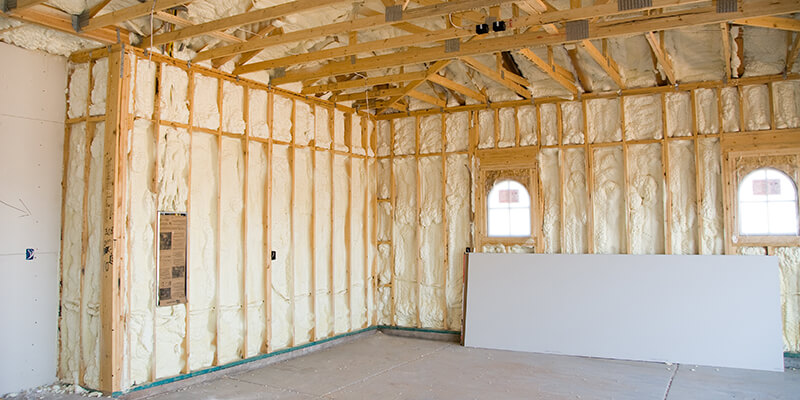Closed Cell vs. Open Cell Foam: Which One’s For You?
In the world of insulation, not all materials are created equal. Two of the most popular options today are closed cell and open cell foam. But which one is right for your needs? Let’s dive into the specifics to find out.
Understanding Closed Cell Foam
Closed cell foam is dense and compact. Here’s what you need to know about it:
- Composition: Its structure consists of tiny bubbles or cells that are completely closed off from each other, hence the name.
- R-value: It generally has a high R-value, meaning it provides excellent insulating properties.
- Moisture Barrier: One of its major advantages is its ability to act as a moisture barrier, preventing mold growth and water damage.
- Durability: This foam tends to be more rigid and offers added structural strength to the spaces it’s applied to.
Getting to Know Open Cell Foam
Open cell foam, on the other hand, has a softer and more flexible composition. Here are its key features:
- Composition: The cells in this foam are not completely closed, allowing for air to fill the gaps.
- R-value: Its R-value is generally lower than that of closed cell foam, but it still provides decent insulation.
- Soundproofing: Open cell foam is often chosen for its sound-deadening qualities.
- Cost: Typically, open cell foam is less expensive than closed cell foam, making it a more budget-friendly choice for many homeowners.
Comparison at a Glance
| Feature | Closed Cell Foam | Open Cell Foam |
| Density | High | Low |
| R-value | High | Moderate |
| Moisture Barrier | Yes | No |
| Cost | Higher | Lower |
| Soundproofing | No | Yes |
Benefits for Your Wallet and the Environment
Beyond the immediate properties of each foam type, there are broader implications to consider:
Energy Efficiency and Savings
- Closed Cell Foam: Its high R-value not only ensures better insulation but can also lead to significant energy savings. With this foam in place, homes often require less energy for heating in the winter and cooling in the summer. Over time, these savings can substantially offset the initial investment.
- Open Cell Foam: While its R-value is lower than closed cell foam, it still provides decent energy efficiency, especially when installed correctly. With reduced energy consumption, homeowners can see a noticeable reduction in their monthly bills.
Environmental Impact
- Sustainability: Both types of foams can be made from sustainable sources. This means that not only are you insulating your home, but you’re also making an environmentally responsible choice.
- Reduction in Carbon Footprint: As these foams contribute to energy efficiency, there’s a reduction in the carbon footprint of homes. Fewer fossil fuels are burned, leading to a decrease in greenhouse gas emissions.
Safety and Health Benefits
- Air Quality: Quality insulation means fewer drafts and a reduction in outdoor pollutants entering the home. This can lead to improved indoor air quality, which is essential for those with allergies or respiratory issues.
- Mold and Mildew Prevention: Especially with closed cell foam, the barrier it creates against moisture can be invaluable. By preventing dampness, it indirectly combats the growth of mold and mildew, ensuring a healthier living environment.
The Role of Professionals
Choosing insulation isn’t just about the material. The expertise in installation plays a massive role in the performance of the foam. Incorrectly installed insulation can lead to gaps, reducing its effectiveness and even causing long-term issues.
For instance, many homeowners in regions like insulation removal San Antonio often face challenges with varying weather conditions. Proper insulation not only safeguards against external temperatures but also aids in regulating indoor humidity levels.
Which One Should You Choose?
Your decision between closed cell and open cell foam should be based on your specific needs. If you live in an area with high humidity and are concerned about moisture, closed cell foam might be the way to go. However, if you’re looking for a more affordable option with good soundproofing capabilities, open cell foam could be your best bet.
In places like San Antonio, homeowners often face unique challenges that require careful consideration of insulation types. Similarly, for those considering attic insulation Houston, understanding the differences between these two foams can be crucial in making the best choice for one’s home.
The Attic Pro Difference
Now, when it comes to insulation, why not rely on experts? Attic Pro has been a game-changer in the industry. With a team of professionals dedicated to ensuring top-notch service, they’ve assisted countless homeowners in making informed decisions about their insulation needs. Whether you’re leaning towards closed cell foam, open cell foam, or are still on the fence, Attic Pro has the experience and expertise to guide you to the perfect solution for your home.
Attic Pro
1646 Vista Del Monte, San Antonio, TX 78216
(210) 750-6966
atticprousa@gmail.com




